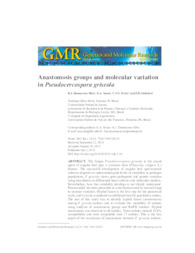Anastomosis groups and molecular variation in Pseudocercospora griseola.
Anastomosis groups and molecular variation in Pseudocercospora griseola.
Author(s): SILVA, K. J. D. e; SOUZA, E. A.; FREIRE, C. N. S.; ISHIKAWA, F. H.
Summary: The fungus Pseudocercospora griseola is the causal agent of angular leaf spot, a common bean (Phaseolus vulgaris L.) disease. The successful development of angular leaf spot-resistant cultivars depends on understanding the levels of variability in pathogen populations. P. griseola shows great pathogenic and genetic variation using inoculation on differential bean cultivars and molecular markers. Nevertheless, how this variability develops is not clearly understood. Parasexuality has been presented as a mechanism used by asexual fungi to increase variation. Hyphal fusion is the first step for the parasexual cycle, and it can be considered an additional trait for population studies. The aim of this study was to identify hyphal fusion (anastomosis) among P. grisola isolates and to evaluate the variability of isolates using analyses of anastomosis groups and RAPD markers. Hyphal anastomosis was observed in all isolates. Three isolates showed 85.0% compatibility and were compatible with 17 isolates. This is the first report of the occurrence of anastomosis between P. griseola isolates. Sixteen anastomosis groups were observed and only one group was formed by five isolates (Pg-01, Pg-02, Pg-07, Pg-08, and Pg-12). There was a large number of anastomosis groups and absence of clustering among isolates for hyphal fusion, demonstrating the existence of genetic variability for loci involved in the control of this trait. High genotypic variability by RAPD markers was detected, but there was no relationship between genotype and anastomosis group. More studies are necessary to elucidate further the process of asexual recombination in this phytopathogen.
Publication year: 2015
Types of publication: Journal article
Unit: Embrapa Mid-North
Observation
Some of Embrapa's publications are published as ePub files. To read them, use or download one of the following free software options to your computer or mobile device. Android: Google Play Books; IOS: iBooks; Windows and Linux: Calibre.
Access other publications
Access the Agricultural Research Database (BDPA) to consult Embrapa's full library collection and records.
Visit Embrapa Bookstore to purchase books and other publications sold by Embrapa.

